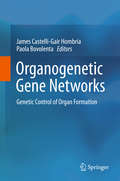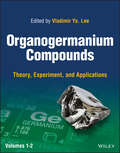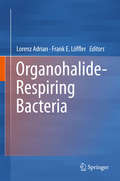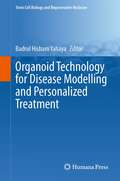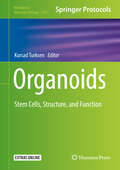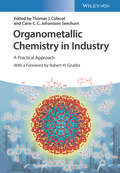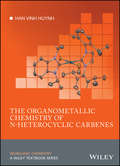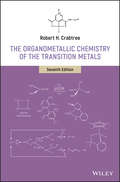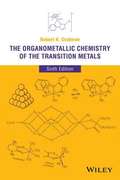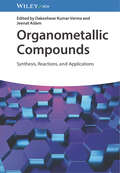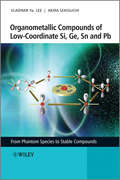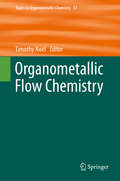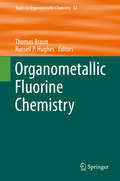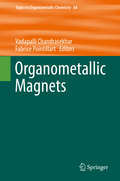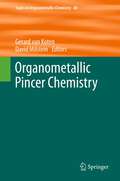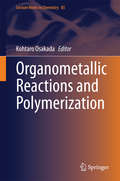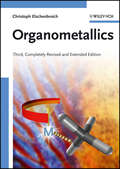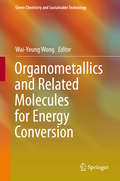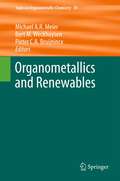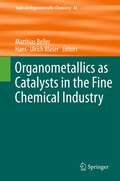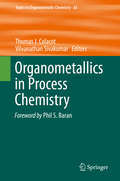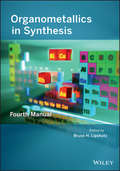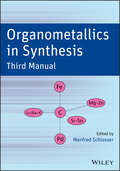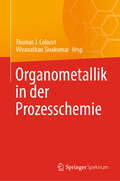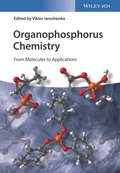- Table View
- List View
Organogenetic Gene Networks
by James Castelli-Gair Hombría Paola BovolentaAll animals, including humans, derive from a single cell, which possesses all the genetic instructions needed to define how the animal will look like. However, during development, the millions of cells that derive from the zygote will only select part of this genetic information to give rise to the various organs of the body. The coordination of different cell behaviours during development results in the formation of specialized tissues and organs giving rise to highly adapted animals. This book provides an overview of how this diversification is achieved during organ formation and how it may have evolved. Conserved cellular processes are presented using examples from selected vertebrate and invertebrate species that illustrate how developmental biologists are solving the complex puzzle of organ formation. This volume is aimed to students, researchers and medical doctors alike who want to find a simple but rigorous introduction on how gene networks control organ formation.
Organogermanium Compounds: Theory, Experiment, and Applications, 2 Volumes
by Vladimir Ya. LeeOrganogermanium Compounds Understand the chemistry of organogermanium compounds with this thorough and cutting-edge reference Discovered comparatively late in the history of chemistry, germanium has become one of the most technology-critical elements in modern industry. Germanium and its inorganic and organic derivatives found widespread applications in fiber- and infrared-optics, electronics, polymerization catalysis, solar electric technology, nanotechnology, chemotherapy, and more. Organogermanium compounds containing carbon to germanium chemical bonds, have applications in microelectronics, medicinal and health industries, and beyond. Organogermanium Compounds: Theory, Experiment, and Applications, 2 Volume Set provides a comprehensive review of this class of compounds in two thorough volumes. It covers all modern aspects of these critically important compounds, including theoretical, synthetic, physico-chemical, and applied research. Reflecting the latest breakthroughs in this rapidly growing field, this book promises to serve as the high-level reference for those readers who are interested in organogermanium chemistry. Organogermanium Compounds readers will also find: 19 chapters produced by leading global experts Descriptions of pivotal historical achievements in organogermanium research Coverage of the latest computational, synthetic, and applied breakthroughs Organogermanium Compounds is a critical reference for researchers and professionals in a wide range of academic and industrial fields working with these fascinating compounds. This will also be helpful for university and college students, at both graduate and undergraduate levels.
Organohalide-Respiring Bacteria
by Lorenz Adrian Frank E. LöfflerThis book summarizes the current state of knowledge concerning bacteria that use halogenated organic compounds as respiratory electron acceptors. The discovery of organohalide-respiring bacteria has expanded the range of electron acceptors used for energy conservation, and serves as a prime example of how scientific discoveries are enabling innovative engineering solutions that have transformed remediation practice. Individual chapters provide in-depth background information on the discovery, isolation, phylogeny, biochemistry, genomic features, and ecology of individual organohalide-respiring genera, including Dehalococcoides, Dehalogenimonas, Dehalobacter, Desulfitobacterium and Sulfurospirillum, as well as organohalide-respiring members of the Deltaproteobacteria. The book introduces readers to the fascinating biology of organohalide-respiring bacteria, offering a valuable resource for students, engineers and practitioners alike.
Organoid Technology for Disease Modelling and Personalized Treatment (Stem Cell Biology and Regenerative Medicine #71)
by Badrul Hisham YahayaOrganoid Technology for Disease Modelling and Personalised Treatment provides a comprehensive overview of current knowledge of the organoid as a human-organ-in-a-dish, a powerful new technology for studying fundamental aspects of human organ development and disease progression in the search for drugs for personalised treatment. This preclinical tool is extensively being utilised as a model for studying human diseases in a dish, which is critical for accurate predictive modelling in precision medicine. The chapters in this book introduces readers to the numerous applications of organoids in various fields of study, as well as ethical considerations associated with organoids. In stem cell biology and regenerative medicine, where chimaera research, biomaterials for tissue vascularisation, gene-editing technologies, and their use in clinical procedures especially issues related to ethical concern over the use of human organoids have gotten much attention. Organoid Technology for Disease Modelling and Personalised Treatment is an excellent resource for in-depth research on one of the most interesting and significant topics in stem cell and regenerative medicine. This book's chapter collection covers a fresh viewpoint on organoid technology that scholars will require reading.
Organoids: Stem Cells, Structure, and Function (Methods in Molecular Biology #1576)
by Kursad TurksenThis detailed volume addresses the challenge of how to instruct stem/early progenitor cells to progress through appropriate steps to generate functional 3-dimensional organs, one of the outstanding issues in regenerative medicine. The field of organoids is geared towards defining and demonstrating the in vitro conditions that achieve this goal. Written for the highly successful Methods in Molecular Biology series, chapters include introductions to their respective topics, lists of the necessary materials and reagents, step-by-step, readily reproducible laboratory protocols, and tips on troubleshooting and avoiding known pitfalls. Comprehensive and cutting-edge, Organoids: Stem Cells, Structure, and Function serves as an aid to researchers working in this vital area of research.
Organometallic Chemistry in Industry: A Practical Approach
by Thomas ColacotShowcases the important role of organometallic chemistry in industrial applications and includes practical examples and case studies This comprehensive book takes a practical approach to how organometallic chemistry is being used in industrial applications. It uniquely offers numerous, real-world examples and case studies that aid working R&D researchers as well as Ph.D. and postdoc students preparing to ace interviews in order to enter the workforce. Edited by two world-leading and established industrial chemists, the book covers flow chemistry (catalytic and non-catalytic organometallic chemistry), various cross-coupling reactions (C-C, C-N, and C-B) in classical batch chemistry, conjugate addition reactions, metathesis, and C-H arylation and achiral hydrogenation reactions. Beginning with an overview of the many industrial milestones within the field over the years, Organometallic Chemistry in Industry: A Practical Approach provides chapters covering: the design, development, and execution of a continuous flow enabled API manufacturing route; continuous manufacturing as an enabling technology for low temperature organometallic chemistry; the development of a nickel-catalyzed enantioselective Mizoroki-Heck coupling; and the development of iron-catalyzed Kumada cross-coupling for the large scale production of Aliskiren intermediates. The book also examines aspects of homogeneous hydrogenation from industrial research; the latest industrial uses of olefin metathesis; and more. -Includes rare industrial case studies difficult to find in current literature -Helps readers successfully carry out their own reactions -Covers topics like flow chemistry, cross-coupling reactions, and dehydrative decarbonylation -Features a foreword by Nobel Laureate R. H. Grubbs -A perfect resource for every R&D researcher in industry -Useful for PhD students and postdocs: excellent preparation for a job interview Organometallic Chemistry in Industry: A Practical Approach is an excellent resource for all chemists, including those working in the pharmaceutical industry and organometallics.
The Organometallic Chemistry of N-heterocyclic Carbenes
by Han Vinh HuynhThe Organometallic Chemistry of N-heterocyclic Carbenes describes various aspects of N-heterocyclic Carbenes (NHCs) and their transition metal complexes at an entry level suitable for advanced undergraduate students and above. The book starts with a historical overview on the quest for carbenes and their complexes. Subsequently, unique properties, reactivities and nomenclature of the four classical NHCs derived from imidazoline, imidazole, benzimidazole and 1,2,4-triazole are elaborated. General and historically relevant synthetic aspects for NHCs, their precursors and complexes are then explained. The book continues with coverage on the preparation and characteristics of selected NHC complexes containing the most common metals in this area, i.e. Ni, Pd, Pt, Ag, Cu, Au, Ru, Rh and Ir. The book concludes with an overview and outlook on the development of various non-classical NHCs beyond the four classical types. Topics covered include: - Stabilization, dimerization and decomposition of NHCs - Stereoelectronic properties of NHCs and their evaluation - Diversity of NHCs - Isomers of NHC complexes and their identification - NMR spectroscopic signatures of NHC complexes - normal, abnormal and mesoionic NHCs The Organometallic Chemistry of N-heterocyclic Carbenes is an essential resource for all students and researchers interested in this increasingly important and popular field of research.
The Organometallic Chemistry of the Transition Metals
by Robert H. CrabtreeThe new edition of this bestselling text continues to provide chemistry students and researchers with vital information on organometallic compounds, their preparation, and use in synthesis. It explores the fundamentals of the field and its modern applications. Includes end-of-chapter problems and their solutions Has up-to-date examples of fundamental reaction steps and emphasis on key topics like oxidation catalysis, CH functionalization, nanoclusters, and nanoparticles Adds coverage for ligand-assisted additions and eliminations, proton-coupled electron transfer, surface catalysis, green energy, and photoredox catalysis
The Organometallic Chemistry of the Transition Metals
by Robert H. CrabtreeFully updated and expanded to reflect recent advances, the sixth edition of this bestselling text provides students and professional chemists with a comprehensive introduction to the principles and general properties of organometallic compounds, as well as including practical information on reaction mechanisms and detailed descriptions of contemporary applications. Increased focus is given to organic synthesis applications, nanoparticle science, and green chemistry.This edition features:New sections on Multifunctional Ligands, Oxidation Catalysis, and Green ChemistryExpanded discussion on topics from the fifth edition: Supramolecular Chemistry, N-Heterocyclic Carbenes, Coupling Reactions, Organometallic Materials, Applications to Organic Synthesis, and Bioorganometallic ChemistryEnd-of-chapter problems and their solutions
Organometallic Compounds: Synthesis, Reactions, and Applications
by Dakeshwar Kumar Verma Jeenat AslamOrganometallic Compounds An up-to-date overview of the fundamentals, synthesis, and applications of organometallic compounds Organometallic Compounds: Synthesis, Reactions, and Applications delivers an accessible and robust introduction to the fundamentals of organometallic compounds, including their reactions, catalytic mechanisms, and modern applications, including carbon-dioxide fixation, reduction, gas adsorption and purification, drug delivery, renewable energy, and wastewater treatment. The book also covers toxicological and computational studies. The authors address the current challenges confronting researchers seeking to sustainably synthesize and process organometallic compounds and offer complete coverage on the most recent advancements in applications relating to the fields of environmental science, electronics, fossil fuels, and more. Readers will also find: Introduces to fundamentals, nomenclature, properties, and classification of organometallic compounds Discusses methods of synthesis of organometallic compounds Practical discussions of organometallic complexes of the lanthanoids and actinoids, as well as bio-organometallic chemistry Includes characterization techniques of organometallic compounds Perfect for organic, environmental, inorganic, water, and catalytic chemists, Organometallic Compounds: Synthesis, Reactions, and Applications will also benefit chemical engineers and industrial chemists.
Organometallic Compounds of Low-Coordinate Si, Ge, Sn and Pb
by Akira Sekiguchi Vladimir Ya. LeeUntil recently the low-coordinate compounds of the heavier elements of group 14 were known only as transient, unstable species which were difficult to isolate. However recent developments have led to the stabilisation of these compounds and today heavier group 14 element cations, radicals, anions, carbene analogues, alkene and alkyne analogues and aromatics have all been prepared as highly reactive, stable, fully characterizable and readily available organometallic reagents.Organometallic Compounds of Low-Coordinate Si, Ge, Sn and Pb describes the chemistry of this exciting new class of organometallics, with an emphasis on their major similarities and differences with the analogous species in organic chemistry. Topics covered include include the synthesis, structure, reactions and synthetic applications of :Si-, Ge-, Sn and Pb-centered cations, radicals and anionsheavy analogues of carbenes: silylenes, germylenes, stannylenes and plumbylenesheavy analogues of alkenes: disilenes, digermenes, distannenes, diplumbenesheavy analogues of alkynes: disilynes, digermynes, distannynes, diplumbynes, and their valence isomersheteronuclear derivatives: silenes, germenes, stannenes, silagermenes, silastannenes, germastannenesheavy analogues of alkenes of the type: >E14=E13-, >E14=E15-, >E14=E16 [where E13, E14, E15 and E16 are elements of the groups 13, 14, 15 and 16]cyclic compounds (three-, four-, five-, and six-membered rings)heavy analogues of 1,3-dienes, allenes and other cumulenesheavy analogues of aromatic compounds; including a comparison between organometallic and organic aromaticityOrganometallic Compounds of Low-Coordinate Si, Ge, Sn and Pb is an essential guide to this emerging class of organometallic reagents for researchers and students in main group, organometallic, synthetic and silicon chemistry
Organometallic Flow Chemistry
by Timothy NoëlThe series Topics in Organometallic Chemistry presents critical overviews of research results in organometallic chemistry. As our understanding of organometallic structure, properties and mechanisms increases, new ways are opened for the design of organometallic compounds and reactions tailored to the needs of such diverse areas as organic synthesis, medical research, biology and materials science. Thus the scope of coverage includes a broad range of topics of pure and applied organometallic chemistry, where new breakthroughs are being achieved that are of significance to a larger scientific audience. The individual volumes of Topics in Organometallic Chemistry are thematic. Review articles are generally invited by the volume editors. All chapters from Topics in Organometallic Chemistry are published OnlineFirst with an individual DOI. In references, Topics in Organometallic Chemistry is abbreviated as Top Organomet Chem and cited as a journal
Organometallic Fluorine Chemistry
by Thomas Braun Russell P. HughesThe series Topics in Organometallic Chemistry presents critical overviews of research results in organometallic chemistry. As our understanding of organometallic structure, properties and mechanisms increases, new ways are opened for the design of organometallic compounds and reactions tailored to the needs of such diverse areas as organic synthesis, medical research, biology and materials science. Thus the scope of coverage includes a broad range of topics in pure and applied organometallic chemistry, where new breakthroughs are being achieved that are of significance to a larger scientific audience. The individual volumes of Topics in Organometallic Chemistry are thematic. Review articles are generally invited by the volume editors.
Organometallic Magnets (Topics in Organometallic Chemistry #64)
by Vadapalli Chandrasekhar Fabrice PointillartThis volume highlights the recent advances and state of art in the experimental and theoretical studies of organometallic magnets. A plethora of organic ligands such as Mannich-base derivatives, redox-active chromophores, cyanides, Schiff base among others are used to coordinate to 3d transition metals, 4f lanthanides and 5f actinides to design the molecular magnets. Deep analysis of the coordination sphere symmetry, electronic distribution, luminescence are investigated to perform magneto-structural correlation leading to a better understanding of the magnetic properties. Furthermore, the rationalization of the magnetic behavior can be reached using ab initio calculations. The multiple applications that these molecular magnets offer could revolutionize the high-density data storage, spintronics and quantum computing technologies. This volume provides a discussion of these topics from leading international experts and will be a useful reference for researchers working in this field.
Organometallic Pincer Chemistry
by Gerard Van Koten David MilsteinGerard van Koten: The Mono-anionic ECE-Pincer Ligand - a Versatile Privileged Ligand Platform: General Considerations.- Elena Poverenov, David Milstein: Non-Innocent Behavior of PCP and PCN Pincer Ligands of Late Metal Complexes.- Dean M. Roddick: Tuning of PCP Pincer Ligand Electronic and Steric Properties.- Gemma R. Freeman, J. A. Gareth Williams: Metal Complexes of Pincer Ligands: Excited States, Photochemistry, and Luminescence.- Davit Zargarian, Annie Castonguay, Denis M. Spasyuk: ECE-Type Pincer Complexes of Nickel.- Roman Jambor and Libor Dostál: The Chemistry of Pincer Complexes of 13 - 15 Main Group Elements.- Kálmán J. Szabo: Pincer Complexes as Catalysts in Organic Chemistry.- Jun-ichi Ito and Hisao Nishiyama: Optically Active Bis(oxazolinyl)phenyl Metal Complexes as Multi-potent Catalysts.- Anthony St. John, Karen I. Goldberg, and D. Michael Heinekey: Pincer Complexes as Catalysts for Amine Borane Dehydrogenation.- Dmitri Gelman and Ronit Romm: PC(sp3)P Transition Metal Pincer Complexes: Properties and Catalytic Applications.- Jennifer Hawk and Steve Craig: Physical Applications of Pincer Complexes.
Organometallic Reactions and Polymerization
by Kohtaro OsakadaThis compilation provides advanced graduate students and researchers with a structured overview of olefin polymerization. Divided into eight chapters written by international experts, this book covers polymerization using various organotransition-metal catalysts, including early and late transition metal complexes, new trends in olefin oligomerization and related reactions. All authors address the historic and scientific backgrounds of the field as well as current research progress and potential for further research. The complete book is designed to present eight independent lectures and, because all authors are well versed in organometallic chemistry, each is based on a profound understanding of the reactions and structures of organotransition metal complexes. This book is an ideal accompaniment for researchers taking courses in olefin polymerization and also serves as a valuable resource for teachers and lecturers of chemistry when planning and researching material for advanced lecture courses.
Organometallics: A Concise Introduction
by Christoph ElschenbroichTHE textbook on organometallic chemistry. Comprehensive and up-to-date, the German original is already a classic, making this third completely revised and updated English edition a must for graduate students and lecturers in chemistry, inorganic chemists, chemists working with/on organometallics, bioinorganic chemists, complex chemists, and libraries. Over one third of the chapters have been expanded to incorporate developments since the previous editions, while the chapter on organometallic catalysis in synthesis and production appears for the first time in this form. From the reviews of the first English editions: 'The selection of material and the order of its presentation is first class ... Students and their instructors will find this book extraordinarily easy to use and extraordinarily useful.' -Chemistry in Britain 'Elschenbroich and Salzer have written the textbook of choice for graduate or senior-level courses that place an equal emphasis on main group element and transition metal organometallic chemistry. ... this book can be unequivocally recommended to any teacher or student of organometallic chemistry.' - Angewandte Chemie International Edition 'The breadth and depth of coverage are outstanding, and the excitement of synthetic organometallic chemistry comes across very strongly.' - Journal of the American Chemical Society
Organometallics and Related Molecules for Energy Conversion
by Wai-Yeung WongThis book presents a critical perspective of the applications of organometallic compounds (including those with metal or metalloid elements) and other related metal complexes as versatile functional materials in the transformation of light into electricity (solar energy conversion) and electricity into light (light generation in light emitting diode), in the reduction of carbon dioxide to useful chemicals, as well as in the safe and efficient production and utilization of hydrogen, which serves as an energy storage medium (i. e. energy carrier). This book focuses on recent research developments in these emerging areas, with an emphasis on fundamental concepts and current applications of functional organometallic complexes and related metal-based molecules for energy research. With contributions from front-line researchers in the field from academia and industry, this timely book provides a valuable contribution to the scientific community in the field of energy science related to metal-based molecular materials. Wai-Yeung Wong, PhD, is Chair Professor and Head of the Department of Chemistry at Hong Kong Baptist University, Hong Kong, P. R. China.
Organometallics and Renewables
by Bert M. Weckhuysen Michael A.R. Meier Pieter C. BruijnincxLucas Montero de Espinosa and Michael A. R. Meier: Olefin Metathesis of Renewable Platform Chemicals.- Pieter C. A. Bruijnincx, Robin Jastrzebski, Peter J. C. Hausoul, Robertus J. M. Klein Gebbink, and Bert M. Weckhuysen: Pd-Catalysed Telomerisation of 1,3-Dienes with Multifunctional Renewable Substrates - Versatile Routes for the Valorisation of Biomass-Derived Platform Molecules.- A Behr, A. J. Vorholt: Hydroformylation and related reactions of renewable resources.- Ties J. Korstanje, Robertus J.M. Klein Gebbink: Catalytic oxidation and deoxygenation of renewables with rhenium complexes.- Antoine Buchard, Clare M. Bakewell, Jonathan Weiner and Charlotte K. Williams: Recent Developments In Catalytic Activation Of Renewable Resources For Polymer Synthesis.
Organometallics as Catalysts in the Fine Chemical Industry
by Matthias Beller Hans-Ulrich BlaserJohannes G. de Vries: Pd-catalyzed coupling reactions.- Gregory T. Whiteker and Christopher J. Cobley: Applications of Rhodium-Catalyzed Hydroformylation in the Pharmaceutical, Agrochemical and Fragrance Industries.- Philippe Dupau: Ruthenium-catalyzed Selective Hydrogenation for Flavor and Fragrance Applications.- Hans-Ulrich Blaser, Benoît Pugin and Felix Spindler: Asymmetric Hydrogenation.- Ioannis Houpis: Case Study: Sequential Pd-catalyzed Cross-Coupling Reactions; Challenges on Scale-up.- Adriano F. Indolese: Pilot Plant Scale Synthesis of an Aryl-Indole - Scale up of a Suzuki Coupling.- Per Ryberg: Development of a Mild and Robust Method for Palladium Catalysed Cyanation on Large Scale.- Cheng-yi Chen: Application of Ring Closing Metathesis Strategy to the Synthesis of Vaniprevir (MK-7009), a 20-Membered Macrocyclic HCV Protease Inhibitor.
Organometallics in Process Chemistry (Topics in Organometallic Chemistry #65)
by Thomas J. Colacot Vilvanathan SivakumarThis volume gives an overview of the applications of organometallic chemistry in process chemistry relevant to the current topics in synthetic chemistry. This volume starts with an introduction on the historical development of organometallics in process chemistry and is followed by chapters dealing with the last five years’ development in various organometallic reaction types such as the challenging cross coupling process, construction of 3.1.0 bicycles, pressure and transfer hydrogenations of historically challenging compounds such as esters, utilization of carbon dioxide for making organic compounds by flow process, drug synthesis and metal detection and scavenging in the finished APIs. A chapter by Colacot et.al., is also devoted to the process development and structural understanding of organometallic catalysts with particular emphasis to LnPd(0) catalysts. An academia – industry collaborated chapter on the use of water as a solvent for organometallic processes is included in this book.
Organometallics in Synthesis
by Bruce H. LipshutzProvides detailed procedures and useful hints on organometallic reactions of Cu, Rh, Ni, and AuWith contributions from leading organic chemists who specialize in the use of organometallics in organic synthesis, this acclaimed Manual offers an especially valuable resource for all synthetic chemists, providing a practical reference for conducting transition metal-mediated synthetic reactions. This Fourth Manual is divided into four chapters:Chapter I: Organocopper ChemistryChapter II: Organorhodium ChemistryChapter III: Organonickel ChemistryChapter IV: Organogold ChemistryEach of these newly written chapters features detailed, practical examples from the literature that guide readers through the preparation of organometallic reagents and their applications in organic synthesis. Procedures are presented in the Manual's acclaimed step-by-step recipe format, enabling both novices and experienced synthetic chemists to perform all the reactions with ease. In addition, the Manual features:Extensive background information on the organometallic chemistry of Cu, Rh, Ni, and AuReferences to the primary literature facilitating further investigation of all the reactions covered in the ManualMechanistic considerations to help readers better understand how the desired products are formedFuture research opportunities for each organometallic classOrganometallics in Synthesis provides extensive and detailed information enabling synthetic chemists to readily assess the applicability of a synthetic method to a given need, and then to perform the reaction with confidence. The Manual covers both established organometallic procedures along with the most recently published protocols.Industrial processes are increasingly relying on organometallic chemistry. In this Manual, readers will find applications to such fields as natural products total synthesis, pharmaceuticals, fine chemicals, biotechnology, agricultural science, polymers, and materials science.
Organometallics in Synthesis, Third Manual
by Manfred SchlosserWINNER of the 2013 PROSE Award in Chemistry & PhysicsThis latest edition enables readers to master new classes of organometallic compounds and synthesesA popular resource used by synthetic organic chemists around the world, this book enables readers to conduct seamless synthetic reactions involving key organometallics. Each reaction is set forth in the book's acclaimed recipe-style format so that readers can easily replicate the results in their own labs. Moreover, each chapter has been written by a world leader in the field of organometallics in organic synthesis. These authors offer hands-on guidance and practical examples illustrating the preparation of organometallics and its application in organic synthesis.This Third Manual of Organometallics in Synthesis features completely new content and topics, with an eye towards providing researchers with the most useful and practical reference on the synthesis of organometallics. Organized into chapters by type of organometallic compound, the book covers:Organoalkali chemistryOrganomagnesium and organozinc chemistryOrganosilicon and relating organotin chemistryOrganoiron chemistryOrganopalladium chemistryWithin each chapter, readers will find background information to learn more about the class of organometallics as well as mechanistic considerations. The authors thoroughly discuss the various methods of preparing the organometallic compounds presented in the book and outline their uses in synthetic reactions. In addition to current applications, the authors explore future research opportunities for each organometallic class. References at the end of each chapter enable readers to explore all the topics in greater depth.More and more industrial processes rely on organometallic chemistry. As a result, readers will find this book's step-by-step instructions essential in such fields as natural product synthesis, pharmaceuticals, fine chemicals, biotechnology, polymers, and materials science.
Organometallik in der Prozesschemie
by Thomas J. Colacot Vilvanathan SivakumarDieser Band gibt einen Überblick über die Anwendungen der metallorganischen Chemie in der Prozesschemie, die für die aktuellen Themen der synthetischen Chemie relevant sind. Der Band beginnt mit einer Einleitung über die historische Entwicklung der Organometallchemie in der Prozesschemie, gefolgt von Kapiteln, die sich mit den Entwicklungen der letzten fünf Jahre bei verschiedenen metallorganischen Reaktionstypen befassen, wie dem anspruchsvollen Kreuzkupplungsprozess, der Konstruktion von 3.1. 0-Fahrrädern, Druck- und Transfer-Hydrierungen von historisch anspruchsvollen Verbindungen wie Estern, der Nutzung von Kohlendioxid für die Herstellung organischer Verbindungen im Durchflussverfahren, der Arzneimittel-Synthese und der Metalldetektion und -reinigung in den fertigen APIs Ein Kapitel von Colacot et.al. ist der Verfahrensentwicklung und dem strukturellen Grundverständnis von metallorganischen Katalysatoren gewidmet, wobei der Schwerpunkt auf LnPd(0)-Katalysatoren liegt Das Buch enthält ein Kapitel über die Verwendung von Wasser als Lösungsmittel für organometallische Prozesse, das in Zusammenarbeit zwischen Wissenschaft und Industrie durchgeführt wurde.
Organophosphorus Chemistry: From Molecules to Applications
by Viktor IaroshenkoFilling the gap for an up-to-date reference that presents the field of organophosphorus chemistry in a comprehensive and clearly structured way, this one-stop source covers the chemistry, properties, and applications from life science and medicine. Divided into two parts, the first presents the chemistry of various phosphorus-containing compounds and their synthesis, including ylides, acids, and heterocycles. The second part then goes on to look at applications in life science and bioorganic chemistry. Last but not least, such important practical aspects as 31P-NMR and protecting strategies for these compounds are presented. <p><p> For organic, bioinorganic, and medicinal chemists, as well as those working on organometallics, and for materials scientists. The book, a contributed work, features a team of renowned scientists from around the world whose expertise spans the many aspects of modern organophosphorus chemistry.
